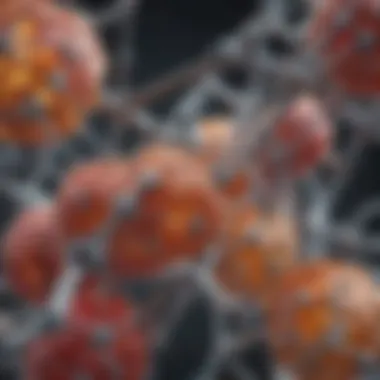A Deep Dive into Amino Acid Nomenclature and Function


Intro
Amino acids are the building blocks of life. They play a vital role in various biological processes and are integral to the formation of proteins, which are essential for the structure and function of cells. Understanding the names and classifications of amino acids is crucial for anyone venturing into the world of biology and biochemistry. This exploration will not only shed light on the complex naming conventions of these molecules but also their significance in living organisms, which can sometimes feel like deciphering a code.
Recent Advances
In the field of amino acid research, recent developments have provided greater insights into how these molecules influence health and disease.
Latest Discoveries
One notable discovery is the role of certain amino acids in metabolic diseases. For instance, researchers have found that branched-chain amino acids are closely linked to insulin resistance. These findings highlight the associated health implications of amino acid metabolism, stirring up discussions about dietary impacts in general. Furthermore, novel amino acids, such as selenocysteine, have emerged, redefining the limits of our amino acid universe, showcasing nature’s diversity.
Technological Innovations
Innovations in mass spectrometry and nuclear magnetic resonance (NMR) have revolutionized the ways we study amino acids. These technologies allow scientists to analyze amino acid sequences and structures with unprecedented accuracy. The advent of these tools has not only enhanced our understanding of amino acid behavior but also paved the way for new drug developments targeting specific amino acid pathways, impacting areas like cancer treatment.
Methodology
A comprehensive understanding of amino acids requires rigorous research methodologies.
Research Design
In much of the current research, comparative analysis is a common approach, where scientists study various amino acids' effects under controlled conditions. They often employ cell cultures or animal models to observe amino acid impacts in vivo, providing clear insights into their biological roles.
Data Collection Techniques
Data collection often involves samples from biological assays that measure enzymatic reactions and metabolic pathways. Researchers utilize advanced techniques, such as gas chromatography-mass spectrometry (GC-MS), to quantify amino acid concentrations in different biological fluids, revealing their dynamic changes in response to various stimuli.
Research in amino acid functions opens doors to novel therapeutic strategies that can address metabolic disorders and beyond.
Prelude to Amino Acids
Amino acids are the building blocks of life, constituting the foundation of proteins which play a myriad of roles in living organisms. Our understanding of amino acids is vital, as they not only serve as essential components in protein synthesis but also participate in various metabolic processes. Without them, biological functions would grind to a halt, causing a ripple effect throughout the complex web of life.
Definition and Importance
Amino acids are organic compounds characterized by the presence of an amino group (-N) and a carboxylic acid group (-COOH). These compounds can be classified into various categories, each with its own unique properties and functions. There are 20 standard amino acids, and their arrangement and combination give rise to countless proteins, each tailored for specific roles in cellular physiology.
The importance of amino acids extends beyond structural components; they are also crucial for synthesizing hormones, neurotransmitters, and enzymes. For instance, the amino acid tryptophan is a precursor to serotonin, a neurotransmitter that regulates mood and sleep. Therefore, understanding amino acids is not just about grasping their definitions, it’s about recognizing their significant impact on health, metabolism, and overall biological processes.
Historical Context
The journey of discovering amino acids stretches back to the early 19th century. The term "amino acid" was first coined in 1850, but it wasn't until the late 1800s that researchers started isolating these compounds. German chemist Emil Fischer played a pivotal role when he established the structure of amino acids and detailed how they link together to form proteins, earning him a Nobel Prize in Chemistry in 1902.
The knowledge of amino acids evolved with advancements in biochemistry and molecular biology. In the 1950s, the importance of amino acids was further reinforced when scientists deciphered portions of the genetic code, linking specific sequences of nucleotides to particular amino acids. This discovery opened new avenues in understanding protein synthesis and genetic expression. Today, research continues to uncover the broader implications of amino acids on health and disease, showcasing their pivotal role in modern science.
Classification of Amino Acids
Understanding the classification of amino acids is crucial as it serves as a foundation for grasping their various roles in biological systems. Amino acids, often referred to as the building blocks of proteins, display a diverse range of properties depending on their structure and side chains. Accurate classification helps biochemists, nutritionists, and even casual learners to appreciate how amino acids influence not just protein formation but also metabolic pathways and overall health. Knowing the distinctions among different types of amino acids can pave the way for exploring their contributions to health, enzyme activities, and even signaling pathways within the body.
Essential vs. Non-Essential
At the forefront of amino acid classification is the distinction between essential and non-essential amino acids. Essential amino acids cannot be synthesized by the body and thus must be obtained through dietary sources. These include leucine, isoleucine, valine, and others. On the other hand, non-essential amino acids can be produced by the body, even if dietary intake is insufficient. This classification is significant as it directs dietary choices, emphasizing the importance of a balanced diet rich in protein sources like meat, dairy, and legumes to ensure an adequate supply of essential amino acids.
"The body’s ability to synthesize non-essential amino acids allows for a certain resilience in dietary intake; however, ignoring essential amino acids can lead to various health issues."
Polar and Non-Polar Amino Acids
Another layer of classification involves polarity. Polar amino acids possess side chains that can form hydrogen bonds with water, making them hydrophilic, or water-loving. This property allows polar amino acids to play critical roles in maintaining protein structures and interactions with biological fluids. Amino acids like serine, threonine, and asparagine fall into this category, making them relevant in processes such as enzyme function and signal transduction.
Conversely, non-polar amino acids, like alanine and phenylalanine, feature hydrophobic side chains that resist water. This hydrophobic nature contributes to the folding of proteins, helping to create the three-dimensional structures necessary for their specific functions. By understanding polarity, one can appreciate how amino acids interact with their environment and how these interactions affect the overall stability and functioning of proteins.


Aromatic Amino Acids
Aromatic amino acids, characterized by their unique ring structures, are another important classification. These include tryptophan, tyrosine, and phenylalanine. The presence of aromatic rings provides these amino acids with distinct properties, such as the ability to absorb ultraviolet light, which is significant for analytical techniques in biochemistry. Moreover, aromatic amino acids often act as precursors in various biosynthetic pathways and exhibit roles in neurotransmitter synthesis, especially tryptophan, which is a precursor for serotonin.
Understanding the functional relevance of aromatic amino acids also lays the groundwork for exploring drug design and therapeutic applications. Their unique properties make them pivotal across multiple areas, from metabolic regulation to the development of pharmaceutical agents.
Amino Acid Structure
The structure of amino acids is fundamental to understanding their role in biological systems. Each amino acid has a unique structure that determines its properties and functions. This section will delve into the essential components of amino acid structures, highlighting how they contribute to the formation of proteins and the diverse functions these proteins serve in living organisms.
Basic Chemical Structure
Amino acids share a common chemical structure that is remarkably consistent, which helps simplify their study. Each amino acid consists of four key components:
- A central carbon atom (C) - This carbon atom is the crux of the amino acid, connected to all the other components.
- An amino group (–NH₂) - This group contains nitrogen and is essential for the classification of these compounds as amino acids.
- A carboxyl group (–COOH) - Functioning as an acid, this group plays a pivotal role in the amino acid's reactivity and interaction with other molecules.
- A hydrogen atom (H) - Attached to the central carbon, this atom is a necessary element of the amino acid's basic structure.
- A variable side chain (R group) - This component varies between different amino acids and determines the unique characteristics of each one.
The above structure enables amino acids to form proteins through peptide bonds, linking them in various sequences and lengths to form complex structures. It's important to note that the arrangement of these amino acids in proteins can lead to vastly different functions, emphasizing the fundamental principle that structure dictates function.
Side Chain Variability
The side chain, or R group, is where the magic really happens - it contributes to the diversity and complexity of amino acids. These side chains range from simple (like the hydrogen atom in glycine) to more complex structures containing aromatic rings or charged groups. The properties of the side chain impact crucial biological functions:
- Polarity: This defines the amino acid's hydrophilicity or hydrophobicity, influencing protein folding and function.
- Charge: Some side chains carry a positive or negative charge, allowing for ionic interactions with other biomolecules.
- Hydrogen bonding: Certain side chains can facilitate hydrogen bonding, which is vital for maintaining a protein's tertiary structure.
Interestingly, the variability of side chains allows for the unique characteristics found in proteins across different species and even among tissues in the same organism. This variability is key to the functionality of essential enzymes, structural proteins, and signaling molecules in the body.
Peptide Bond Formation
Peptide bonds are the lifeline of protein structure. These bonds result from a dehydration synthesis reaction between the amino group of one amino acid and the carboxyl group of another, releasing a water molecule in the process. This reaction forms a covalent bond, leading to the formation of long chains called peptides.
Key points about peptide bond formation include:
- Stability: Peptide bonds are known for their stability, making them resilient against hydrolysis, allowing proteins to maintain their structure in varying environments.
- Directionality: The resulting peptide has a distinct N-terminus (amino end) and C-terminus (carboxyl end), which is crucial for the synthesis and ultimately the function of proteins.
- Flexibility and Rigidity: While the peptide bond is generally rigid due to partial double-bond character, the bonds between the alpha carbon and the R groups allow for rotation, introducing flexibility in protein structure.
This concise yet complex process ensures that amino acids can assemble into proteins, leading to the creation of every enzyme, hormone, and structural element critical to life's processes. The intricacies of amino acid structure reveal much about their champion role in biochemistry.
"The diversity of amino acid structures is what gives life its complexity and versatility."
In summary, understanding amino acid structure is pivotal as it lays the groundwork for the entire field of biochemistry and molecular biology. Without a firm grasp of these intricate details, one cannot fully appreciate the marvelous machinery of life that proteins embody.
The Role of Amino Acids in Proteins
Amino acids are often regarded as the building blocks of proteins, and rightfully so. They are not just random components but crucial players in the functionality of biological systems. Understanding their role in proteins offers insight into how life operates at a molecular level, emphasizing their importance in everything from nutrition to genetic coding. The relationship between amino acids and proteins is deeply intertwined, and unraveling this connection could shed light on many biological processes.
Protein Synthesis Process
The journey of protein synthesis is a fascinating saga involving amino acids that begins with the genetic code. Inside the nucleus of a cell, DNA transcribes its information to messenger RNA (mRNA), which then travels out to ribosomes—often described as the molecular factories of the cell. The ribosomes serve as platforms where the magic happens.
- Initiation: The mRNA binds to the ribosome, where the process kicks off precisely at the start codon. This codon signals the starting point for assembling the amino acid chain.
- Elongation: Transfer RNA (tRNA) plays a vital role during elongation. Each tRNA molecule is attached to a specific amino acid and carries it to the ribosome. The ribosome reads the codons on the mRNA and aligns the corresponding tRNA, linking amino acids together to form a polypeptide chain. The tRNA then exits, ready to transport the next amino acid.
- Termination: Eventually, the ribosome reaches a stop codon on the mRNA, prompting the finished polypeptide to release and undergo further modifications.
This protein synthesis process illustrates how essential amino acids are in constructing proteins, which ultimately serve countless functions ranging from catalyzing metabolic reactions to providing structural support in cells. Thus, the importance of amino acids transcends mere assembly; they are at the heart of cellular functionality.
Folding and Functionality
However, simply stringing amino acids together in a sequence does not dictate the form or function of a protein. After synthesis, the polypeptide chain must fold into a precise three-dimensional structure to operate effectively. This folding process is critical because the specific shape determines how the protein interacts with other molecules.
- Primary Structure: The sequence of amino acids forms the primary structure, but this is only the beginning.
- Secondary Structure: The chain often begins folding into shapes like alpha-helices and beta-pleated sheets due to hydrogen bonding.
- Tertiary Structure: Further folding occurs, driven by interactions among side chains, resulting in a robust and functional structure.
- Quaternary Structure: In some cases, multiple polypeptide chains come together, forming a complex protein structure.
"A protein’s functionality is inherently dependent on its structure. A slight change in the amino acid sequence can result in a significant alteration in the protein's overall shape, potentially disrupting its function entirely."
The folding process underscores why even a minor change in the sequence of amino acids can lead to considerable implications. Misfolded proteins can result in diseases such as Alzheimer's and cystic fibrosis, highlighting the profound implications of amino acids within biological systems. Therefore, the intricate choreography of amino acid sequencing, synthesis, and folding is utterly essential for maintaining life as we know it.


Genetic Coding and Amino Acids
Genetic coding plays a pivotal role in life as we know it. It’s the blueprint that decrees how amino acids combine to form proteins, the very machinery of biological function. Understanding this relationship is crucial in the realm of biology and biochemistry. This section sheds light on the genetic code's mechanics and importance, focusing on its implications for the translation process, which ultimately dictates protein synthesis and function.
The Genetic Code
The genetic code can be likened to a language, wherein sequences of nucleotides within DNA correspond directly to specific amino acids. This trio of nucleotides is referred to as a codon and serves as an instruction manual for building proteins in living organisms.
- Each amino acid is represented by one or more codons:
- For example, AUG codes for Methionine, which also serves as the start codon for protein synthesis.
- UAA, UGA, and UAG serve as stop codons, signaling the termination of protein translation.
The universality of this code across nearly all organisms signifies its evolutionary significance. It suggests a common ancestry and outlines evolutionary processes that led to the diversity of life forms we observe today. The genetic code remains consistent, with rare exceptions noted in some organisms, further enhancing its foundational role in biology.
"Understanding the genetic code is not just about sequencing genes; it is about grasping the very fabric that connects molecular biology with life itself."
Translation Mechanism
Translation is the second step in the protein synthesis pathway, where messenger RNA (mRNA) is decoded to produce polypeptides. This process is like an assembly line—precise, systematic, and highly regulated. Here’s a breakdown of how it unfolds:
- Initiation:
The small ribosomal subunit binds to the mRNA. The start codon (usually AUG) signals the beginning of the translation. - Elongation:
- Termination:
- Transfer RNA (tRNA) molecules bring amino acids to the ribosome in accordance with the codon sequences.
- As each tRNA pairs with the corresponding codon, the ribosome facilitates the formation of peptide bonds between amino acids, elongating the polypeptide chain.
- When the ribosome encounters a stop codon, the translation stops. Release factors help detach the newly formed polypeptide, which will undergo folding and modifications to become a functional protein.
The efficiency of translation hinges on various factors such as ribosomal activity, availability of tRNA, and the stability of the mRNA. Any disruptions in these processes can lead to misfolded proteins or nonfunctional polypeptides, which might contribute to various diseases or disorders.
By exploring these mechanisms, we grasp not only the biochemical processes at play but also their relevance in fields like genetics, medicine, and biotechnology. The interplay between genetic coding and amino acids exemplifies the beauty of molecular biology.
Specific Amino Acid Names and Their Functions
Understanding specific amino acid names and their functions is vital in the intricate world of biochemistry. Each amino acid, with its unique side chain, contributes differently to protein structure and functionality. Recognizing these differences goes beyond mere nomenclature; it forms the foundation for comprehending biological processes and the role these small but mighty molecules play in life itself. By delving into the characteristics and functions of amino acids, one can appreciate their contribution to health, nutrition, and even metabolic pathways.
Commonly Known Amino Acids
Among the twenty standard amino acids, some stand out due to their universal presence and distinct functions in the human body. Here are a few notable ones:
- Glutamine – As the most abundant free amino acid in the bloodstream, glutamine plays a crucial role in immune function and gut health. It serves as a fuel source for enterocytes and lymphocytes, showing its importance in recovery and muscle growth.
- Lysine – Often regarded as an essential amino acid, lysine is vital for protein synthesis and the production of hormones and enzymes. It also plays a role in calcium absorption, contributing to overall bone health.
- Tyrosine – Known for its role in synthesizing neurotransmitters like dopamine and norepinephrine, tyrosine supports cognitive function and mood regulation.
Exploring these amino acids reveals how their specific names delineate their roles and the biochemical complexity they embody.
Unique Characteristics of Amino Acids
Each amino acid contains unique properties stemming from its side chain. This variability impacts how they interact in various chemical environments. For instance:
- Hydrophobic vs. Hydrophilic – Amino acids can be grouped based on the behavior of their side chains in water. Hydrophobic amino acids, like phenylalanine and valine, tend to avoid water, leading to clustering away from the aqueous environment. In contrast, hydrophilic amino acids such as serine and lysine, with their willingness to mix with water, play significant roles in enzyme catalysis and molecular recognition.
- Charged Side Chains – The side chains of amino acids can be positively or negatively charged under physiological conditions. For example, aspartate and glutamate are negatively charged, contributing to neuro signaling, while arginine and lysine carry a positive charge, playing vital roles in protein interactions and catalysis.
These characteristics enable amino acids to perform a range of functions that support life.
Role in Metabolism
Amino acids don't just serve as building blocks of proteins; they participate in critical metabolic pathways. Here’s an overview of their metabolic roles:
- Precursor Molecules – Many amino acids serve as precursors for various biologically important molecules. Tryptophan, for instance, is a precursor for serotonin, influencing mood and sleep patterns.
- Energy Production – During times of energy demand, amino acids can be converted into glucose through gluconeogenesis, supplying energy when carbohydrate intake is low.
- Synthesis of Biomolecules – They are also pivotal in synthesizing hormones, neurotransmitters, and other nitrogenous compounds, thus contributing to maintaining homeostasis in the body.
"Amino acids are not merely building blocks; they are intricate players in the orchestra of biochemistry, each contributing to the symphony of life."
By dissecting these elements, it becomes clear how specific amino acid names indicate their functions and relevance in biological systems. Understanding this complexity is a stepping stone for students, educators, and researchers to further explore amino acid biochemistry.
Amino Acids and Health


Amino acids play a crucial role in maintaining overall health. Their importance goes beyond just being the building blocks of proteins; they are involved in numerous biological processes. This section will explore how amino acids can be beneficial in nutrition, as well as the implications of deficiencies, which can lead to a variety of health issues.
Amino Acids in Nutrition
Amino acids are essential for a balanced diet. They can be classified into two main categories: essential and non-essential amino acids. Essential amino acids must be obtained from food since the body cannot produce them. On the other hand, non-essential amino acids can be synthesized by the body.
The role of amino acids in nutrition can be observed in several key areas:
- Protein Synthesis: Amino acids are vital for the synthesis of proteins, which are necessary for muscle repair and growth.
- Hormone Regulation: Certain amino acids function as precursors for hormones, influencing metabolism and growth.
- Immune Function: They assist in the production of antibodies, fortifying the immune system's ability to combat infections.
- Neurotransmitter Production: Some amino acids are critical for synthesizing neurotransmitters, which regulate mood and cognitive functions.
Incorporating a variety of protein sources in one’s diet can ensure adequate intake of all the essential amino acids. Foods rich in amino acids include meat, fish, dairy, legumes, nuts, and soy products.
Deficiencies and Health Implications
A lack of adequate amino acid intake can lead to a plethora of health problems. Deficiencies often manifest in various stages and can cause both short-term and long-term effects on health. Here are some notable implications of insufficient amino acids:
- Muscle Wasting: Inadequate amino acids can lead to muscle atrophy and reduce overall strength.
- Weakened Immune Response: A deficiency may lower the body’s ability to fight off infections.
- Hormonal Imbalance: Insufficient amino acids can disrupt hormone levels, impacting growth and metabolism.
- Cognitive Issues: A lack of certain amino acids that contribute to neurotransmitter synthesis can affect mood and cognitive functions.
"A well-rounded diet rich in amino acids is a pivotal factor for maintaining health and wellness. Deficiencies can ripple through various bodily functions, leading to unforeseen complications."
Addressing these deficiencies is important, particularly through dietary adjustments or supplementation when necessary. Attention to amino acid intake is not just about protein; it’s about ensuring holistic health, vitality, and robustness.
In summary, understanding amino acids in nutrition and recognizing the consequences of deficiencies are vital for promoting optimal health. A strategic approach to including various dietary sources of amino acids can prevent many potential health issues.
Recent Advances in Amino Acid Research
Recent progress in research surrounding amino acids has shed new light on their multifaceted roles in biological systems. As our understanding of these compounds deepens, so does the recognition of their potential applications, both in health and nutrition as well as in therapeutic contexts. The ability to manipulate amino acids or harness their properties could lead to innovative treatments for various ailments. Let's explore some pioneering studies and findings in this area.
Innovative Studies and Findings
In recent years, various studies have opened new avenues for understanding amino acids. For instance, research has indicated the role of branched-chain amino acids in muscle recovery and metabolism. Studies suggest that these amino acids can enhance athletic performance and post-exercise recovery. Interestingly, it has been observed that individuals who consumed a diet higher in these amino acids showed better muscle health and less soreness after intense physical activities.
Moreover, advancements in genomics have facilitated an in-depth analysis of how specific amino acids influence gene expression. Research conducted in 2020 highlighted that valine can modulate metabolic pathways linked with obesity and diabetes.
Another fascinating study uncovered the link between tryptophan and mental health, suggesting that variations in this amino acid can impact serotonin production in the brain. As such, it points towards the significance of nutrition in mental well-being, making a case for dietary interventions in mood regulation.
“Amino acids are not just building blocks of proteins; they can also dictate metabolic and physiological pathways, influencing our overall health.”
Future Directions
Looking ahead, the potential of amino acid research appears vast and promising. Some scientists are delving into the engineering of amino acids to create novel compounds for drug development. For example, researchers are exploring amino acid derivatives as potential inhibitors for certain cancer cell lines, which could lead to the development of more effective chemotherapy agents with fewer side effects.
Further, ongoing studies are focusing on personalized nutrition. Integrating genomic data with amino acid profiling could allow for tailor-made dietary recommendations that optimize individual health outcomes. This personalized approach may ensure that people receive the right amino acids in the right amounts based on their metabolic needs and health conditions.
In addition, the exploration of amino acids in the field of probiotics is gaining traction. Some studies indicate that specific strains of probiotics could enhance amino acid absorption, leading to better overall health, particularly in individuals with digestive disorders.
In summary, the realm of amino acid research continues to evolve. Whether it's promoting health in athletes or unlocking new therapies for chronic diseases, the findings promise a fresh wave in biosciences. The intersection of nutrition, mental health, and innovative drug development is a fertile ground for future inquiry, and amino acids stand at the forefront of this exploration.
Epilogue
The final chapter of this exploration brings us to reflect on the significance of amino acid names and their relevance across various disciplines. We’ve traversed through definitions, classifications, and intricate structures of amino acids, yet each of these elements ties back to a fundamental conclusion: understanding amino acids is essential not only for biochemistry but for health, nutrition, and biotechnology.
In summary, acknowledging the specific names and functions of amino acids enhances our grasp of molecular biology. Their role in protein synthesis is pivotal; without these building blocks, life as we know it would not exist. Each amino acid, from the well-known glycine to the more complex tryptophan, carries its unique narrative that contributes to vast biological functions. This underscores the necessity for students and professionals alike to appreciate the diversity in amino acid structures and their biological impacts.
Moreover, as we close this detailed narrative, it is apparent that new avenues in amino acid research hold profound implications. This can influence not just academic studies but also nutritional strategies and therapeutic approaches, reflecting on the benefits of amino acids in clinical settings.
Summary of Key Points
- Diversity of Amino Acids: The spectrum ranges from essential to non-essential amino acids, each serving specific functions within the body.
- Role in Protein Synthesis: Understanding the translation mechanism of amino acids is critical to grasp how proteins are formed. Amino acids link together through peptide bonds, creating polypeptides that fold into functional proteins.
- Significance in Health: Amino acids are vital for various metabolic pathways, which can affect overall health. Deficiencies lead to significant health issues, emphasizing the need for balanced nutrition.
- Research and Innovation: The landscape of amino acid research is ever-evolving, marking greater insights into their roles in health and dietary needs.
Implications for Further Research
As we consider the journey of amino acids, it becomes evident that ongoing research could lead to remarkable discoveries in several crucial areas:
- Nutritional Science: Understanding how specific amino acids can affect mental health or physical performance will open new doors for dietary recommendations.
- Clinical Applications: Research into amino acids as therapeutic agents for health disorders can lead to innovative treatments for conditions like muscle wasting or metabolic diseases.
- Biotechnology: The development of amino acid derivatives is already impacting the pharmaceutical industry, with potential for creating better drugs. Further investigation into their synthesis and application could yield additional benefits.
In closing, the nuances of amino acids and their names serve as more than just academic knowledge; they have practical implications that resonate in healthcare, nutrition, and biological sciences. Continuing to explore these compounds promises exciting advancements and deeper understanding in the ongoing dialogue between biology and health.















